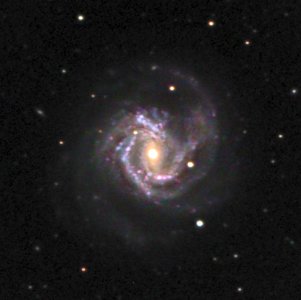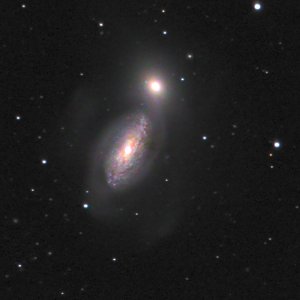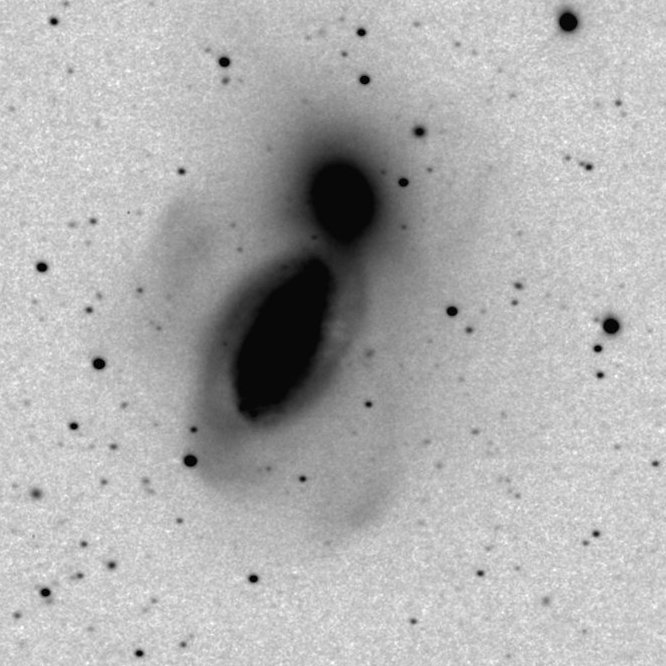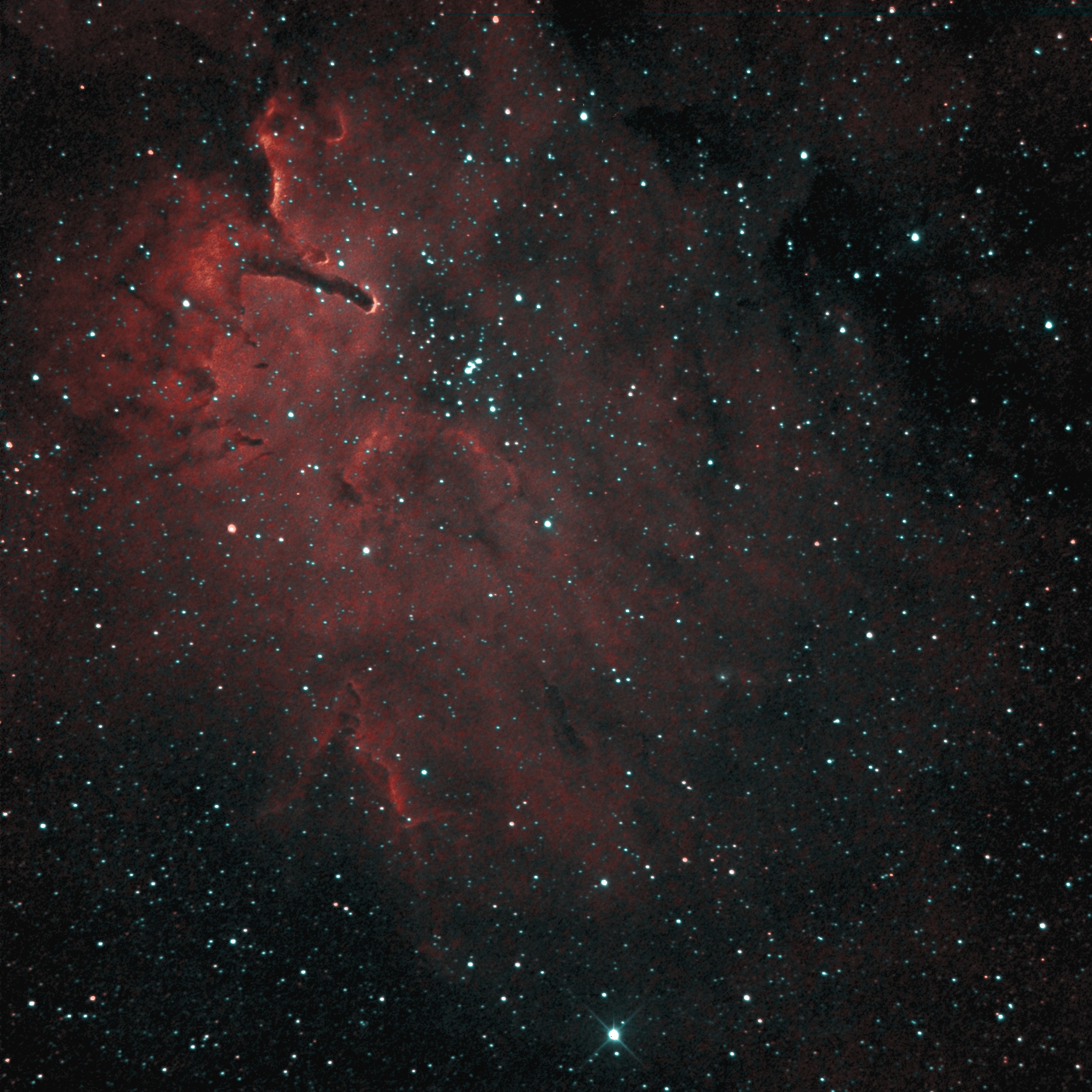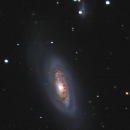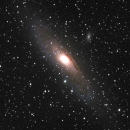 |
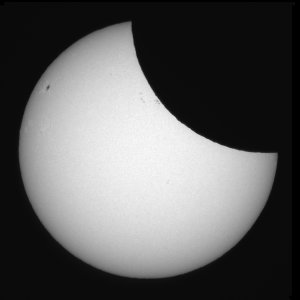 |
PARTIAL SOLAR ECLIPSE 29 MARCH 2025 Left: 12u08 local time, near maximum. Top: 11u23, 11u46, 12u08, 12u33 and 12u47 Leica f=300mm telephoto lens at f/D=8.0 on Fork-mount Raspberry Pi HQ camera (G and B channels added) Baader L-filter (IR-cut-off) Lens covered with aluminized (partially transparent) mirror Exposure time 0.15 millisec |
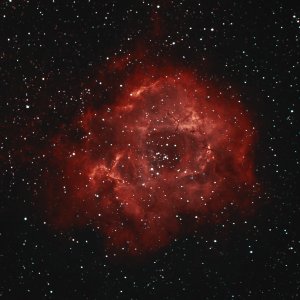 |
ROSETTE NEBULA, HOO-palette 1, 16, 17 and 18 febr. 2025 FTF2020-M full-frame CCD camera Leica f=300mm telephoto lens f/D=4.0 on Fork-mount FoV: 3.5 x 4.2 degr. Filters: Baader Planetarium with a 6.5nm bandwidth H-alpha 112x180 sec OIII 105x180 sec |
 |
SUNSPOTS 3839 .. 3844 October 4, 2024 15cm Newton, f/D=6.3 (f=960mm) Raspberry Pi HQ camera Balzers Calflex IR-blocking filter Telescope covered with 2 layers of Mylar sheet Exposure time 0.1 millisec |
Comet Tsuchinshan-ATLAS (C/2023 A3) during twilight of October 23, 24, 25 and 27, 2024.Equipment: FTF2020M CCD with IR-blocking filter on 25cm f/D=5.7 Newton (f=1455mm). Sum of 9 exposures of 60 seconds. Click on the left image for an overview of the four photographs covering a field of view of 0.76x0.70 degrees each. The images are processed with an unsharp mask using a rotational uniform filter over 16 degrees centered on the comet's head. Details in the comet's tail are enhanced by a factor of 3.Click on the right image for a gif showing, in a loop, the unprocessed and sharpened images, albeit with limited greyscale depth! (Click here for a 'mouse-over' version of the unsharp masked and non sharpened (but still processed!) images.) |
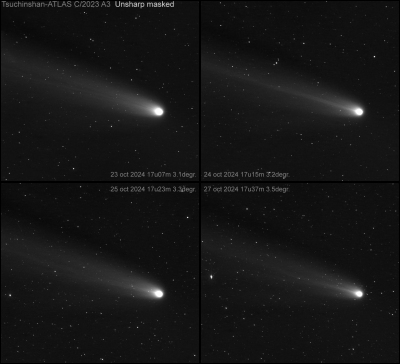 |
TSUCHINSHAN-ATLAS (C/2023 A3) October 23, 24, 25 & 27, 2024 Scope: 25cm Newton f/D=5.7 CCD: FTF2020-M Filter: Melles Griot IR-blocking Exposure: 9x60 seconds FoV each: 0.76x0.70 degrees |
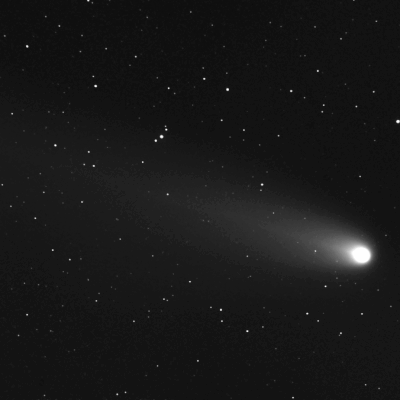 |
 |
HELIX NEBULA HOO palette Oct. 4, 22, 23 and 25 (Ha), and Oct. 5 & Nov. 3 (OIII) 2024 Leitz f=300mm Telephoto obj. at f/D=4 FTT1010-M CCD on Fork-mount Baader 6.5nm H-alpha & OIII filters Exposure: H-alpha 156x3min and OIII 126x3min FoV: 1.8x1.6 degr |
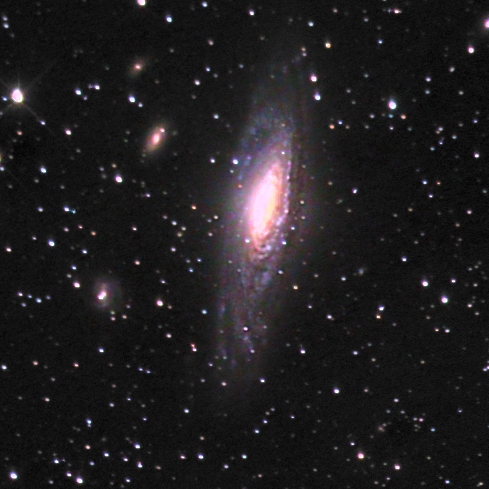 |
NGC 7331 & STEPHAN'S QUINTET October 4 (L) and October 5 (RGB) 2024 25cm Newton f/D=5.7 FTF2020M CCD with Edmund Optics RGB-filters Exposure: L 34x120 + 48x150 sec RGB 24x150sec each Brightest stars 'thinned' FoV: 0.64x0.76 degr |
| (Click here for earlier Veil Nebula images/attempts: 2007, 2004 and 2003) |
|
Nearly a full year, from end of august 2023 till june 2024, the Netherlands had a record year in terms of precipitation. Related to that, the number of relatively bright nights over that period could be counted 'using the fingers of one hand'. I had to combine results obtained in 2022, 2023 and 2024 to come to the images of M63 and PK205 shown below. Hopefully the record-high Atlantic Ocean's surface temperature, causing all the extra moisture and clouding in the Netherlands, will become lower with a deminishing El Nino, although I expect that with ongoing global warming we (in the Netherlands) will have to get used to fewer astrophotography opportunities.... |
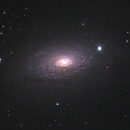 |
M63 SUNFLOWER GALAXY April 2023 (L) and May 2024 (RGB) 25cm Newton f/D=5.7 FTT1010-M CCD with Edmund Optics RGB-filters Exposure: L 48x120sec RGB 35x120sec FoV: 0.43x0.29 degr (click here for earlier attempts: 2001 and 1998) |
 |
MEDUSA nebula HOO palette March 2022 (Ha), Feb/Mar 2024 (Oiii) 25cm Newton f/D=5.7 FTT1010M CCD with Baader 6.5nm H-alpha and OIII filters H-alpha 203*120 sec OIII 131*150 sec FoV: 0.39x0.39 degr |
|
Dumbbell nebula revisited with H-alpha and OIII filters. I've copied earlier photographs of the Dumbbell nebula that were taken with RGB-filters (2007) and the FTF1020C colour CCD (2000, now out-of-use).
|
|
Coincidentally I photographed M101 on 17 May 2023, two days before supernova SN2023ixf was discovered. On 19 may I could confirm the supernova during a short break in the clouds. The wheather cleared on 24 May and the few astronomically dark hours enabled me to photograph M101 and SN2023ixf in L and RGB. Below the results shown in different ways. Image information: Equipment: 25cm Newton f/D=5.7 with FTT1010M CCD and RGB filterwheel Sub-image exposures: 17 May: Luminance 15*120sec 24 May: Luminance 30*120sec 25 May: RGB 30*120sec eachFoV: 0.48x0.44 deg |

|

|

|
| Gif switching between 17 and 24/25 May 2023 |
17 May and 24 May side by side | Sum of 17 and 24/25 May images |
|
M42 imaged with SII, H-alpha and OIII narrow-band filters (Baader Planetarium, 6.5-8.5nm bandwidth), shown in three different ways. To the left H-alpha is shown in Red while the OIII image is distributed over Green (100%) and Blue (100%) to obtain the characteristic teal colour. The middle image has the same colour assignment and is unsharp masked, i.e. the luminance of the image was devided by a smoothed version of itself, lowering the intensity of the central part of the nebula and revealing the (nearly overexposed) trapezium star cluster. The image to the right shows M42 with H-alpha again assigned to Red (150%), S-II to Green (400%) and OIII to Green (80%) and Blue (100%). In order to have a clear effect, the Sulfur contribution had to be increased 4-fold. Images are obtained on february 8, 2023, with the FTT1010-M CCD camera and the f/D=3.5 Newton configuration described below (and in the equipment section, see here). M42 is a relatively bright object and for H-alpha and OIII short, 60-second exposures were needed to avoid overexposure of the central part: H-alpha 19x60 seconds, OIII 30x60seconds. The Sulfur contribution is much weaker and 16 exposures of 120 seconds were acquired. The images cover a 0.8x0.8 degree field of view, are sharpened and shown with a gamma of 2.2. The luminance is based on the (photopic) eye sensitivity for the H-alpha wavelength (656nm: sensitivity 0.08) and OIII wavelength (501nm: sensitivity 0.34). Thus L=0.08*H-alpha+0.34*OIII. |
Horse nebula HOO 14/27/28 february 2023 H-alpha 155x2min OIII 95x2min FoV 0.73x0.73 degrees Gamma 2.0 Intenser red contributions are shown with increasing whiter appearance The image is sharpened and rotated 90-degrees (CCW) |
 |
 |
 |
 |
| M42, HOO | M42, HOO, Unsharp masked. |
M42, HSO | Horsehead nebula |
|
Images obtained with the FTT1010-M CCD camera and my latest Newton telescope. In fact it is a modified Cassegrain telescope with a 25cm, f=1091mm primary. By adding a
plane-convex lens close to the CCD the effective focal length is reduced to f=880mm and the f/D is improved from 4.3 to 3.5. Without this lens, coma of the parabolic primary over the 12mmx12mm focal plane of the CCD is substantial. The plano-convex lens reduces coma and increases sensitivity by some 50% (which compensates for the relatively low quantum efficiency of the CCD's I'm (still) using). For more details click here. The images are cropped to 0.5x0.5 degrees of the 0.8x0.8 degrees field of view. The bandwidth of the H-alpha and OIII filters are 6.5nm and 8.5nm (Baader-Planetarium). |

